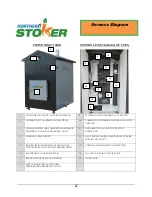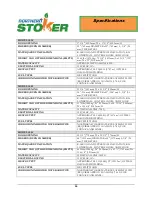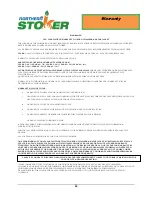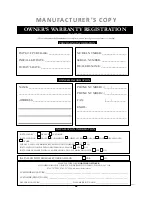
9
When you purchased your Northern Stoker, you bought a heavy duty, high output very efficient furnace. In
order for the furnace to work properly, it must be fired with the proper fuel. Dry Wood! If the wood you
burn is too high in moisture, excessive amounts of creosote will accumulate and cause problems.
CREOSOTE
: -Formation and need for removal- When wood is burned slowly, it produces tar and other
organic vapors, which combine with expelled moisture to form creosote. The creosote vapors condense in
the relatively cool chimney flue of a slow burning fire. As a result, creosote residue accumulates on the flue
lining. When ignited, this creosote will make an extremely hot fire. When burning wood, the chimney
connector and chimney should be inspected at least once every two months, during the heating season to
determine if a creosote buildup has occurred. If creosote has accumulated, it should be removed to reduce
the risk of a chimney fire.
DISPOSAL OF ASHES: -
Ashes should be placed in a metal container with a tight fitting lid. The closed
container of ashes should be placed on a non-combustible floor or on the ground, well away from the
combustible materials, pending final disposal. If the ashes are disposed of by burial in soil or otherwise locally
dispersed, they should be retained in the closed container until all cinders have thoroughly cooled.
1.
When you go to your furnace in the morning, and the fuel is very low (a bed of coals), this is the
time to look at the combustion chamber walls. If there is a light layer of soot, fly ash and/or
creosote, use a scraper for this job and scrape down the combustion chamber.
2.
Go to the control house and open the heat exchanger doors, pull out the ash tray directly below and
turn the top auger first in the direction indicated by the arrows and then bottom auger. This will
clean the heat exchanger tubes and deposit the fly ash back into the combustion chamber. Every two
(2) weeks or there about, it is advisable to remove the augers and clean the augers with a wire brush,
then scrape the heat exchanger tubes with a scraper. Whenever doing this, wear safety glasses and
leather gloves.
3.
After a few days of continuous burning, ash will begin to accumulate in the combustion chamber.
This ash is removed by way of the fire loading door and a shovel. When removing ash, try to
remove as little charcoal and live embers as possible. The ash should be placed in a metal container,
with a metal lid that is tight fitting. The closed container of ashes should be placed on a non-
combustible surface, well away from all combustible materials, pending final disposal. If the ashes
are disposed of by burial in soil or otherwise locally dispersed, they should be retained in the closed
container until all cinders have thoroughly cooled. This can take two (2) or (3) days to cool.
4.
At some point in time, you may notice that the fire has become lazy or not as hot and robust as it
was compared to the first firing. This may be due to ash build up under the combustion grate. Some
ash may have gone down the air holes and accumulated there. By opening the combustion chamber
blower air injection door in the control house, the ash can easily be removed with a scraper and pan.
As required, the entire grate can be removed for complete ash removal. This should be done when
there are no hot embers present. Follow directions outlined in paragraph section 3 on this page.
5.
When cleaning ashes this is a good time to check the condition of the doors, latches & hinges. It is
also necessary to maintain seals in good condition. If door seal is not soft & pliable it should be
replaced, contact your Northern Stoker Dealer for a new door seal. (This is a consumable product.)
Starting a Fire
CAUTION! NEVER LEAVE AN OPEN DOOR.
Do not operate with fuel loading or ash removal doors open.
Summary of Contents for 30-30
Page 23: ...21 Notes...












































